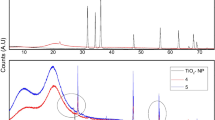Abstract
In this work, poly(methyl methacrylate-co-methylacrylate acid)/ZnO (poly(MMA–MAA)/ZnO) composite latex particle was synthesized by three steps The first step was to synthesize poly(MMA–MAA) copolymer latex particles by soapless emulsion polymerization. Following the first step, the second step was to polymerize MMA, MAA and 3,3-(trimethoxysilyl) propyl methacrylate (MPS) in the presence of poly(MMA–MAA) seed latex particles to form the poly(MMA–MAA)/poly(MMA–MAA–MPS) core–shell latex particles. In the third step, the poly(MMA–MAA)/poly(MMA–MAA–MPS) latex particles reacted with ZnO nanoparticles, which were synthesized by a traditional sol gel method, to form the polymer/inorganic poly(MMA–MAA)/poly(MMA–MAA–MPS)/ZnO composite latex. In this study, MPS with silanol groups essentially was used as the coupling agent to couple with ZnO nanoparticles, while the results of the study showed that there was not covalent bond existed between ZnO particles and polymer latex. The ZnO particles were adsorbed on the surface of polymer latex by electrostatic interaction. Besides, the linear poly(MMA–MAA)/crosslinking poly(MMA–MAA–MPS) core–shell latex particles which were synthesized in the second step were heated in the presence of ammonia to form the hollow poly(MMA–MAA–MPS) latex particles. The factors of heating time and concentration of crosslinking agent significantly influenced the morphology of hollow poly(MMA–MAA–MPS) latex particles.











Similar content being viewed by others
References
Meng QB, Takahashi K, Zhang XT, Sutanto I, Rao TN, Sato O, Fuji shima A, Watanabe H, Nakamori T, Uragami M (2003) Fabrication of an efficient solid-state dye-sensitized solar cell. Langmuir 19:572–3574
Gao T, Wang TH (2005) Synthesis and properties of multipod-shaped ZnO nanorods for gas-sensor applications. Appl Phys A 80:1451–1454
Houabes M, Metz R (2007) Rare earth oxides effects on both the threshold voltage and energy absorption capability of ZnO varistors. Ceram Int 33:1191–1197
Liu DS, Wu CY, Sheu CS, Tsai FC, Li CH (2006) The preparation of piezoelectric ZnO films by RF magnetron sputtering for layered surface acoustic wave device applications. Jpn J Appl Phys I 45(4):3531–3536
Kang XY, Wang TD, Han Y, Tao MD, Tu MJ (1997) Sol-gel process doped ZnO nanopowders and their grain growth. Mater Res Bull 32:1165–1171
Lu CH, Yeh CH (2000) Influence of hydrothermal conditions on the morphology and particle size of zinc oxide powder. Ceram Int 26:351–357
Kim KS, Kim HW (2003) Synthesis of ZnO nanorod on bare Si substrate using metal organic chemical vapor deposition. Phys B 328(3–4):368–371
Audebrand N, Auffredic JP, Louer D (1998) X-ray diffraction study of the early stages of the growth of nanoscale zinc oxide crystallites obtained from thermal decomposition of four precursors. General concepts on precursor-dependent microstructural properties. Chem Mater 10:2450–2461
Yang Y, Chen HL, Zhao B, Bao XM (2004) Size control of ZnO nanoparticles via thermal decomposition of zinc acetate coated on organic additives. J Crystal Growth 263(1–4):447–453
Luo YD, Dai CA, Chiu WY (2008) Synthesis of P(AA-SA)/ZnO composite latex particles via inverse miniemulsion polymerization and its application in pH regulation and UV shielding. J Polym Sci A 46:8081–8090
Zhou J, Zhang SW, Qiao XG, Li XQ, Wu LM (2006) Synthesis of SiO2/poly(styrene-co-butyl acrylate) nanocomposite microspheres via miniemulsion polymerization. J Polym Sci A 44:3202–3209
Al-Ghamdi GH, Sudol ED, Dimonie VL, El-Aasser MS (2006) Encapsulatin of titanium dioxide in styrene/n-butyl acrylate copolymer by miniemulsion polymerization. J Appl Polym Sci 101:3479–3486
Caruso F (2000) Hollow capsule processing through colloidal templating and self-assembly. Chem Eur J 6:413–419
Stewart S, Liu GJ (1999) Hollow nanospheres from polyisoprene-block-poly(2-cinnamoylethyl methacrylate)-block-poly(tert-butyl acrylate). Chem Mater 11:1048–1054
General S, Rudloff J, Thunemann AF (2002) Hollow nanoparticles via stepwise complexation and selective decomplexation of poly(ethylene imine). Chem Commun 5:534–535
Gittins DI, Caruso F (2000) Multilayered polymer nanocapsules derived from gold nanoparticle templates. Adv Mater 12:1947–1949
Jang J, Ha H (2002) Fabrication of hollow polystyrene nanospheres in microemulsion polymerization using triblock copolymers. Langmuir 18:5613–5618
Donath E, Sukhorukov GB, Caruso F, Davis SA, Mőhwald H (1998) Novel hollow polymer shells by colloid-templated assembly of polyelectrolytes. Angew Chem Int Ed 37:2201–2205
Sukhorukov GB, Donath E, Davis S, Lichtenfeld H, Caruso F, Popov VI, Mőhwald H (1998) Stepwise polyelectrolyte assembly on particle surfaces: a novel approach to colloid design. Polymer Adv Technol 9:759–767
Steitz R, Leiner V, Tauer K, Khrenov V, Klitzing Rv (2002) Ultraviolet and visible Raman spectroscopy characterization of diamond-like carbon film growth by pulsed laser deposition. Appl Phys A 74:519–523
Glinel K, Sukhorukov GB, Mőhwald H, Khrenov V, Tauer K (2003) Thermosensitive hollow capsules based on thermoresponsive polyelectrolytes macromol. Chem Phys 204:1784–1790
Brayner R, Ferrari-Iliou R (2006) Toxicological impact studies based on Escherichia coli bacteria in ultrafine ZnO nanoparticles colloidal medium. Nano Lett 6:866–870
Tang E, Cheng G (2006) Preparation of nano-ZnO/PMMA composite particles via grafting of the copolymer onto the surface of zinc oxide nanoparticles. Powder Technol 161:209–214
Author information
Authors and Affiliations
Corresponding author
Rights and permissions
About this article
Cite this article
Lee, CF., Liu, YS. The preparation and characteristics of poly(methyl methacrylate–methylacrylate acid)/nano-ZnO composite latex particles. Polym. Bull. 67, 1245–1259 (2011). https://doi.org/10.1007/s00289-011-0484-1
Received:
Revised:
Accepted:
Published:
Issue Date:
DOI: https://doi.org/10.1007/s00289-011-0484-1




